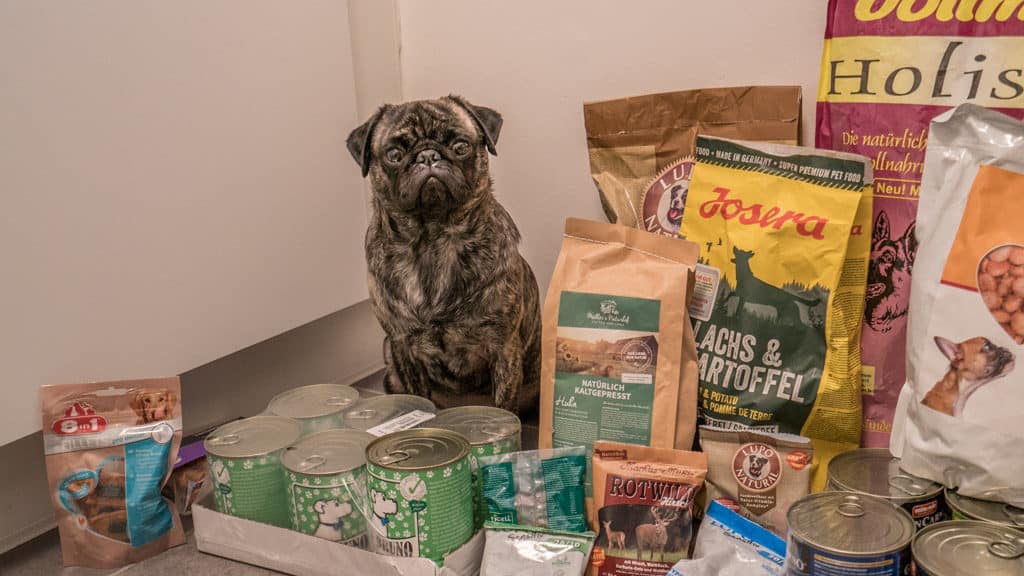How Much Does a Dog Cost? (Basic Equipment, Month, Year)
- from Claudia Weise
- Updated: February 16, 2024
Not sure how much a dog costs? In this article, you will learn about the long-term costs of owning a dog. You'll get a comprehensive overview of one-time, regular, and recurring costs.

What Are the One-Time Costs?
Obviously, the largest expense is the purchase. The acquisition costs are made up of the purchase price for a puppy from a breeder or the adoption fee for a dog from a shelter and the cost of the initial equipment.

1. Acquisition Cost
The initial costs are incurred at the time of purchase. How much you will have to pay for your dog depends on whether you are buying a shelter dog or a pedigree dog.
A dog from an animal shelter or a humane society is the cheapest alternative. Here you only have to pay a protection fee of 150 to 300 Euros. This fee only covers the cost of maintaining the dog for the shelter.
If you choose a pedigree dog from a breeder, the price will depend on the breed. You should always find out what the breed of dog of your choice normally costs.
If the price is well below average, it is probably not a reputable breeder. The most important thing is that you like the puppy and the breeder. The price should be secondary.
Depending on the breed, the price can range from $500 to $2500. You can expect to pay between $600 and $1000 for a Pug. A Labrador puppy will cost you between $1000 and $1400. If you want an English Bulldog, the price can be between $1700 and $2300.
Prices for certain breeds depend on these 6 factors:
- Size of the breed: The bigger, the more expensive
- Rarity: How many breeders are there?
- Training level: Is the dog trained? (relevant e.g. for hunting dogs)
- Demand: How popular is the breed at the moment?
- Special growing conditions and characteristics
- Additional costs for the breeder
2. Initial Equipment Costs
The cost of basic equipment varies depending on the quality and brand of the products. You can expect to spend between $100 and $500. In general, investing in quality pays off in the long run, as quality products last longer and contribute to your dog's health.
You can save money or spend a fortune on accessories. There are big price differences depending on the material, workmanship and brand.
Look for good workmanship and non-toxic materials. It's best to get advice from a pet store. Another price factor is the size of your dog. The bigger your dog, the more expensive the accessories will be because they will be bigger.
To make sure your new family member has everything he or she needs, purchase the accessories before you move in:
1. Dog Bed or Basket
A cozy dog bed or basket is the first step in giving your dog a home away from home. It should be large enough for your dog to lie down comfortably and soft enough for him to sleep well. Cost: $20-$100 depending on size and quality. Luxury models can be considerably more expensive.
2. Food and Water Bowl
Quality food and water dishes are essential. Stainless steel or ceramic are durable materials that are easy to clean. Make sure the bowls are non-slip to minimize spills. The cost: Basic models from $5 per bowl, higher quality or special models up to $30 per bowl.
3. Leash, Collar and Possibly Harness
A sturdy collar and leash are required for walks and training. A harness may be a good alternative, especially for dogs that tend to pull on the leash or breeds with sensitive necks. Cost: Collar: from $5 to $50, depending on material and design. Leash: between $10 and $50, depending on length, material and functionality. Harness: from $15 to $60, depending on size and features such as padding and adjustability.
4. Carrying Case or Bag for Safe Transportation
A carrier is important not only for travel, but also for trips to the vet or on vacation. It should be large enough for the dog to turn around in and be well ventilated. Costs: Transport boxes: Between $20 and $150, depending on size and material. Transport bags: Between $20 and $100, depending on size and design.
5. Toys to Keep Them Occupied
Toys not only help prevent boredom and keep your dog mentally stimulated, but they also strengthen the bond between you. A mix of chew, fetch, and intelligence toys is ideal. Cost: Small toys start at around $3, while interactive or robust toys can cost up to $30 or more.
6. Brushes and Care Products
Depending on your dog's coat type, you may need brushes or combs. Grooming products such as shampoo should be tailored to your dog's skin type. Costs Brushes and combs: about $5 to $30, depending on type and quality. Grooming products such as shampoo: about $5 to $20 per bottle.
7. Food and Treats
Choose a quality food that meets your dog's nutritional needs. Treats are useful during training and as a reward. Costs Food: The monthly cost is between $20 and $100, depending on the size of the dog and the quality of the food. Treats: Between $5 and $20 per month, depending on quantity and quality.
In addition, puppies from breeders may incur additional veterinary costs of approx. 45 euros for the microchip and EU pet passport.
What Are the Regular Costs?
Of course, you also have to consider the ongoing costs. After all, the purchase is not the end of the story. Here you can find out what costs you will incur on a regular basis:
1. Dog Food
When it comes to dog food, it depends on the feeding method and the quality of the food. Whether you choose BARF, dry or wet food is up to you. You should also give your pet treats from time to time.
Because dog food prices vary widely, it is not possible to determine a fixed monthly cost.
A second factor that affects the cost of food is the size of your dog. A large dog will eat much more than a small one.
For a medium-sized dog, you can expect to pay between €50 and €100 per month for premium food. Make sure it is a quality food that is tailored to your dog's needs.
2. Veterinarian
You can schedule vaccinations and worming once or twice a year. This will cost you between $100 and $200 per year. This preventive health care is important to keep your dog healthy. Unfortunately, there are no guarantees.
In the event of an accident, expensive surgery can quickly become necessary. That's why you should always have a pet emergency fund. Having to operate can easily cost over €1000. Diseases that require a blood test (about €120) are also expensive.
3. Dog Tax
As a dog owner, you are required to pay dog license fees in Germany. However, the tax rate varies depending on the city or town. Check with your local government for the exact amount.
Your first dog will cost between €60 and €240 per year. However, prices can vary greatly depending on the breed registry of each state.
If your four-legged friend is a listed dog, higher amounts of $500 to $900 per year may apply for certain breeds. As a general rule, you can expect to pay a multiple of the normal tax rate for "fighting dogs".
4. Insurance
Insurance is another important topic that also incurs regular costs. Two different types of insurance are relevant here: One Liability insurance is compulsory in most federal states. Even if this is not the case, you should still take out liability insurance.
If your dog destroys other people's property, you are on the safe side. A vase can easily be knocked over, a tire can easily be bitten. Liability insurance can save you a lot of money. You can get a good dog liability insurance for as little as $60 a year.
Dog health insurance is an important investment, especially as your dog ages. As your four-legged friend gets older, he or she will need to visit the vet more often. You should purchase pet health insurance early.
Most insurance companies no longer accept dogs over a certain age. The age of entry also determines the monthly premiums: The older your dog gets, the more expensive it will be. There are different types of insurance. You can expect to pay around €50 per month for full coverage. If you choose surgery only, you will pay around €15 a month.
5. Care Products

Your pet has his own grooming routine. You will need an appropriate dog shampoo for regular grooming. You should also use a tick and flea repellent to keep pests away from your four-legged friend. The cost of grooming products is not high. You can expect to pay around $50 per year.
6. Dog Salon
Depending on your dog's coat type or breed, regular grooming visits may be necessary. A complete grooming, including bathing, blow-drying, trimming or clipping, ear, eye and nail care, will cost between $45 and $150, depending on breed and size.
What Are the Additional Costs?
Of course, not all costs are predictable. As mentioned in the section on veterinary costs, high costs can be incurred due to illness and surgery. But there are also other irregular costs:
Diet Food
In the case of food intolerance or obesity, special dietary foods must be used. This is more expensive than regular food.
Castration
If you adopted your dog from the shelter, he is already neutered. Otherwise a Castration recommended. It protects against diseases and of course against unwanted reproduction. A male dog can be neutered for around €100, a female dog is more expensive at around €400.
Dog Sitter / Boarding Kennels
Dog owners want to go on vacation too. It's not always possible to take your pet with you. If neither family nor friends can take your dog, the only option is to hire a dog sitter or boarding kennel. You can expect to pay between €20-30 per day.
Cleaning or Repair Costs
Unfortunately, it is not a rumor that dogs like to chew on furniture or stain carpets. Puppies, especially when they are teething, like to gnaw on everything from sofas to shoes.
It is always a good idea to provide your puppy with a chew toy. However, accidents can happen quickly. Cleaning and repair costs are likely.
Puppy or Dog School
To ensure that your pet listens to you and is well-behaved, you should consider attending a dog training school. Especially as an inexperienced dog owner, it will be difficult for you to pay attention to all the details when training your four-legged friend. To avoid damaging your relationship, you should leave the training to the professionals. One Dog school costs between $150 and $300.
Broken or Old Dog Accessories
Even the best accessories wear out or break. When that happens, they need to be replaced. Make sure they are of good quality so your pet can enjoy them for a long time.
How Much Does a Dog Cost per Month?
The monthly costs for a dog can vary greatly depending on the size, breed, individual needs and amount of care required. Below is a rough estimate of monthly costs to help you plan a budget for your four-legged friend:
Exhausting
Between $20 and $100 per month, depending on the dog's size and food quality. Special diets for dogs with special nutritional needs may be more expensive.
Veterinary and Health Care
Regular veterinary costs can range from $10-$50 per month averaged over the year. This includes routine exams, vaccinations, and parasite control. However, unforeseen illness or injury costs can significantly increase this amount.
Insurance
Liability insurance is compulsory for dog owners in many regions and costs between 5 and 15 euros per month. Additional health insurance for dogs can cost between €20 and €50 per month, depending on the level of cover.
Accessories and Care
Toys, treats, brushes, shampoo and other accessories can cost between $10 and $30 per month. Professional grooming services, such as coat care or nail trimming, which are required on a regular basis, especially for certain breeds, can increase the cost.
Other Costs
The dog license fee varies from municipality to municipality. It can range from $5 to over $20 per month. Dog school or training, dog sitting or day care can also be very expensive.
Rough Estimate
A rough estimate of how much a dog will cost monthly ranges from $50 to over $200. However, this varies greatly and can be significantly higher for large dogs or dogs with special needs, as well as if additional services are used.
It's important to consider all of these factors when thinking about getting a dog. Good financial planning will help ensure that you can give your dog a healthy and happy life without unexpected financial pressures.
Annual Costs
The annual cost of a dog depends on many factors, including size, breed, health, and lifestyle. Here's a detailed breakdown of annual costs to give you an idea of what to expect:
- Exhausting
Cost: $240 to $1,200. High-quality food for a medium to large dog costs about $50 to $100 per month, and less for smaller dogs. - Veterinary and Health Care
Routine examinations and vaccinations: $100 to $200.
Prevention against parasites (fleas, ticks, worms): $60 to $120.
Unforeseen illness or injury: These costs can vary widely and can run into the thousands if special treatments or surgeries are required. - Dog Tax
Cost: $60 to $240 per year, depending on the municipality and breed. - Liability insurance
Cost: 60 to 180 euros per year for basic cover. - Health insurance (optional)
Cost: $240 to $600 per year, depending on the scope of the insurance cover. - Accessories and care products
Initial equipment: $100 to $500 for beds, bowls, leads, toys etc.
Running costs: $120 to $360 for toys, treats, shampoo, brushes. - Professional care
Cost: $0 to $500 per year, depending on breed and care requirements. - Training:
Cost: $0 to $500 for courses or professional training. - Other
Cost: Dog care during vacation or business trips can cost from $0 to over $1,000, depending on the number of trips and type of accommodation (boarding kennel, dog sitter). - Total costs
Based on these estimates, the annual cost of a dog can range from $820 to over $4,000. This estimate covers basic needs and includes some optional expenses, but unforeseen costs can add to the budget.
It is important to realize that a dog is a long-term financial commitment. In addition to basic needs, unexpected expenses may arise, especially those related to the dog's health. Good planning and an emergency fund for unforeseen expenses can help protect you and your dog from unexpected financial burdens.
Conclusion
As you can see, a dog can cost a lot and is certainly not an inexpensive pet. There is no general answer to the question of how much a dog costs per month. The factors mentioned above play a large role in the monthly cost.
If you want to get a registered dog or a larger dog, you can expect even higher costs. If your pet has an accident or becomes seriously ill, the costs will increase dramatically.
You should also keep in mind that the average life span of a dog is 12 years. Are you willing and able to spend that much money every month for the long term?
Only if you are sure that you can give your dog a good life should you get a dog.

I'm editor-in-chief at Hundeo and when it comes to dogs, my heart beats faster. My goal is to publish the best dog guides on the web. There is a lot of passion in every article and I welcome any feedback to constantly improve our content.
Share Now:

